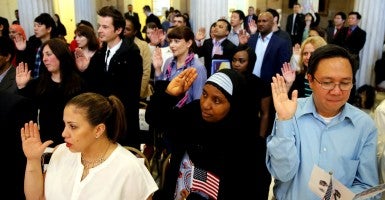We spend a lot of time debating immigration as a society. This is natural, as it is an important policy that always, one way or another, inflames passions.
Curiously, though, we spend a lot less time discussing what happens after immigrants come to the United States.
This is peculiar, because it is by how immigrants and their children prosper, or whether they are assimilating and contributing to society, that others often judge them. That many succeed is beyond doubt. No fewer than four children of immigrants who came in the 1950s or earlier—Ted Cruz, Marco Rubio, Bernie Sanders, and Donald Trump—are presidential candidates today.
Assimilation has always been, in the words of neoconservative luminary Norman Podhoretz, a “brutal but necessary bargain.” America perfected the assimilationist model over its first 300 years because immigrants began streaming into the colonies soon after Jamestown was first established.
Over the past four or five decades, however, America has turned its back on this model and opted instead for a “multicultural” approach that emphasizes group differences. In a new Heritage Foundation special report, I argue that this trend is dangerous to representative government. The next president should make it a priority to reverse this course.
The multicultural model has consisted of the following elements, all fraught with perverse incentives: bureaucratically dividing the nation into five “ethnic groups,” two of which, Asians and Hispanics, comprise mostly recent immigrants; convincing these immigrants that they are “minorities” who are victims of a history of discrimination in a racist country; and dispensing benefits and social standing based on this victim status, encouraging thereby further cultural segregation and a damaging culture of victimhood.
This approach has coincided with our most recent surge of immigration, the one that came in after the Immigration Act of 1965, and with the ascendancy within academia of “Critical Theory.”
This holds that American institutions and traditions, and Western ones in general, are self-servingly set up to preserve the privileges of the “dominant” group. Failing armed revolt, which is unlikely to come, “subservient” groups can only replace the hegemony with a “counter-narrative.”
It is about time we undid this damage. Here are five policies from my paper that’ll help solve the problem.
- Re-evaluate the practice of segregating American residents by group.
Americans need to ask why, or whether, it is necessary to segregate American residents in the constitutionally mandated decennial Census or any of the other surveys the U.S. government conducts in between.
If it is demographical information that the country and its academics need, then the government could ask residents to check boxes according to nationalities of origin. There is no need to deepen cultural cleavages by encouraging people to identify with one of five bureaucratically created pan-national groups.
- Debate how the Founding history of the United States should be taught in schools and universities.
Americans need a robust debate on the indoctrination of young minds by schools and universities. No society can survive a sustained denigration of its history and principles.
- Allow school-choice reform.
One way that those designated as minorities today are indeed victims who risk being relegated to a permanent subordinate class is by being left behind educationally. This is especially true for those designated as Hispanics, whom the National Assessment of Educational Progress shows to consistently lag behind. Not coincidentally, Hispanics are overrepresented in public schools, especially in urban areas, where public schools most struggle and underperform. Unfortunately, efforts to fix the system are often stymied by politicians’ dependence on support from teachers unions that oppose true reforms. Candidates should ask why the country should continue to let teachers unions block meaningful school-choice reform, thus relegating immigrants and their children to the status of a permanent subordinate class.
- Strengthen citizenship requirements.
Another area that needs debate. Some 54 percent of the 41 million foreign-born U.S. residents in 2012 were not citizens (around 22 million), so making civic and patriotic instruction part of the naturalization process would go a long way toward making naturalization a truly transformative experience and would help assimilate a significant portion of immigrant communities.
Any immigration reform that a future president signs should include reinforcing citizenship requirements so as to start our new compatriots with a deep and thorough understanding of the elements that make America exceptional.
- Prevent government policies that harm family formation and church participation.
The vast scholarship on previous immigrant surges shows that the family and the church are strong mediating institutions that aid in the assimilation process. The American family, as the Manhattan Institute’s Kay Hymowitz states, always had the mission of shaping “children into citizens in a democratic polity.” As for church attendance, vast amounts of research show that children who attend church regularly result in having more years of schooling, helping with economic mobility, and assimilation.































